Maison G. deNavarre
Maison G. deNavarre was born Edward Lewis Maicki in Poland in 1909, which explains why his friends referred to him simply as Ed. Shortly after his birth, his parents – Marion Maicki [c.1882-1952] and Bronislawa (Bernice) Maicki, nee Gwiazdowska [c.1895-1958] – emigrated to the United States arriving with their three children in 1910. Starting in Reynoldsville, Pennsylvania, the family moved to Clearfield for a while before settling to Detroit by which time three more children had been added.
Edward adopted the name Maison Gabriel deNavarre in the early 1930s. It may have started as a nom de plume but the change became permanent sometime between 1933 and his marriage to Jeanette Rita Dutts in 1938. Maison had met Jeanette while working at the Sherman Laboratory in Detroit and they had two children together, Edward [1939-2008] and Marietta [1942-1997].
Pharmacy
Maison’s career in cosmetic chemistry started in pharmacy. After graduating from Cass Technical High School, Detroit in 1926, he followed his older brother, John Robert Maicki [1901-1982], into the College of the City of Detroit (renamed Wayne University in 1934) where he received a Bachelor of Science in Pharmacy in 1930.
While at college, Maison was involved with a number of social activities. He was on the editorial staff for ‘The Griffin’, the college annual; a reporter for ‘The Collegian’; and also produced cartoons for ‘The Jabberwock’ a college humour magazine. He was also a founding member of the pharmacy fraternity, Phi Delta Chi, its vice-president in 1929, and master-at-arms in 1930.
When Maison graduated, the Great Depression was rapidly approaching its low point. In these difficult economic times he gained employment as a drug store clerk, both full-time and part-time, while working to complete his Masters in Pharmaceutical Chemistry (1939) back at his alma mater, and establishing himself as a consulting chemist.
It was a tough year for Ed to get out of school. His classmates went to work in their fathers’ drugstores. Ed’s father didn’t have a drugstore. There were very, very few jobs. Besides, his feet hurt. He didn’t like standing around; pharmacists always walk and stand around. But he also was always real interested in science, and he just had enough guts and was confident enough of himself to be a consultant. His background was all pharmacy, but as pharmaceutical manufacturers cleaned up their act, the next group in line were the cosmetic manufacturers and Ed just very easily moved into that field. He was in the right place at the right time, and he had the right attitude. He could help people, he liked doing it, and he was obviously very good at it.
(50 years of the Society of Cosmetic Chemists, 1995)
Consulting chemist
Maison’s first contract as a consulting chemist was with George Beeman, the founder of Beauty Counselor, in 1934 (Klarmann, 1952, p. 135). This began a long-term relationship between Maison and the firm. Further work followed, leading the creation of Maison G. deNavarre Associates with Frederick Mittelstadt (chemist) and Ralph J. Mill (pharmacist and attorney) in 1940. The business was situated at 14934 Harper Avenue, Detroit, the same address as the Great Lakes Pharmacy run by another brother of Maison, Henry Joseph Maicki [1903-1990], who was also in the pharmacy business.
American Perfumer
In addition to his consulting work, Maison also began establishing himself as a voice for the cosmetic industry through writing articles for trade magazines that covered cosmetics, starting with ‘The American Perfumer and Essential Oil Review’ (American Perfumer).
The first article Maison wrote for American Perfumer was ‘Absorption bases’, which appeared in the December, 1932 issue. Encouraged by Stephen L. Mayham [1892-1970], a long-time editor of American Perfumer, this was followed by ‘Vitamins A and D in cosmetics’ in May, 1933. By then, Maison had also begin his ‘Desiderata’ column in American Perfumer, its first appearance being in the April, 1933 edition. Maison’s valuable contributions to American Perfumer were recognised in 1935 when he was made the journal’s Technical Editor. In 1959, Maison was appointed Editorial Director of American Perfumer, now called ‘American Perfumer and Aromatics’ and he remained with the publication through many name changes after that.
Maison’s contributions to American Perfumer undoubtedly helped cement his standing amongst cosmetic chemists which, in turn, helped his consultancy business. However, this was not his primary motivation. He was genuinely interested in improving standards in the manufacture of cosmetics and did this though his consulting business, writing articles in trade publications and books, and developing educational programs.
Many [formulators] had no degrees. In the old days, they were lucky if they knew chemistry at all. They grew up mixing pills or making creams and lotions in their little buckets. But a lot of them were very, very clever – could turn out very good cosmetics in a very consistent way. But they didn’t have all the scientific background. They just learned it.
(50 years of the Society of Cosmetic Chemists, 1995)
Cosmetics course
To help train pharmacy students in cosmetic chemistry, Maison convinced the Dean of the Wayne University College of Pharmacy, Roland T. Lakey [1883-1986] into offering a course in cosmetics. This was made part of the night school program for many years before being transferred to Saturdays.
Articles and books
Through the 1930s, Maison continued to write a wide variety of articles in trade journals like American Perfumer and ‘The Manufacturing Chemist’ and continued providing advice to manufacturers through his Desiderata column. He also presented papers to the Toilet Goods Association and The Society of Cosmetic Chemists. Original articles by him or reprints were also published in oversea trade journals such as ‘La Parfumerie Moderne’, ‘The Chemist & Druggist’ and ‘The Perfumery and Essential Oil Record’.
His extensive knowledge and interest in all aspects of cosmetic chemistry led to him writing ‘The Chemistry and Manufacture of Cosmetics’ (1941), widely acclaimed as one of the most comprehensive books on cosmetic chemistry available at the time. As an added bonus, it included a chapter on the Federal Food, Drug and Cosmetic Act of 1938. Written by Ralph J. Mill from Wayne University it helped American readers comply with the terms of the act.
Currently, the book has passed through three major editions. The second, expanded to four volumes released between 1962 and 1975, contained a number of articles by Maison along with others written by fellow contributors. The third, released between 2000 and 2002, in three volumes but four books, was published after Maison’s death with Mitchell L. Schlossman as the editor. This edition was an almost complete rewrite but a few chapters were still attributed to Maison even though they had been extensively revised by others.
In 1943, Maison began writing a second manuscript entitled ‘The Production Control and Analysis of Cosmetics’. The first four chapters were serialised in American Perfumer and in the British journal ‘Soap, Perfumery & Cosmetics’ (Klarmann, 1952, p. 139) but the project was abandoned. However, Maison did complete another book, the ‘International Encyclopedia of Cosmetic Trade Names’ in 1957.
The Society of Cosmetic Chemists
During the Second World War, Maison worked as an expert consultant for the Engineer Board at Fort Belvoir to develop a Camouflage Stick but as the war drew to a close he returned to a project he had tried to initiate earlier on, a society for cosmetic chemists.
As previously mentioned, Maison had joined a number of clubs and associations as a student. In 1933, he had also established the Michigan Cosmetic & Extract Association with the help of Ralph M. Stevenson [1982-1964]. In 1935, in an attempt to create a national organisation, Maison had contacted the twelve cosmetic chemists he could find in the United States but none turned up to a meeting to establish a society for chemists involved in the toilet goods industry.
Undaunted, Maison returned to the idea at the end of the war. In March, 1945, he made a plea to any scientist working in cosmetics:
“No one asks you to tell all you know, but there is something you can share with others. No matter how little, it is a contribution to the growth of the industry. Stop taking only. Give when you take.” He said that keeping knowledge within the company is “wrong because invariably the boss or the technician learned what they know in part from trade and scientific journals. If people before them had been as selfish, no one would know anything. The cosmetic industry is of age now. It should be aware of the fact that to progress it must do research, published and exchanged with others.”
(50 years of the Society of Cosmetic Chemists, 1995)
This time his efforts met with success. In May 23, 1945, the founding meeting of the Society of Cosmetic Chemists (SCC) was held at the Hotel Lexington in New York. In December 5, 1945, the first meeting of the newly formed SCC was held with Maison elected its first president. Maison is therefore considered the SCC’s founding father and, in recognition of this, the society named its highest honor – the Maison G. de Navarre Medal – after him.
Beauty Counselor
In 1946, Maison abandoned his consulting practice and joined Cosmetic Laboratories, Inc. the owners of Beauty Counselor. Cosmetic Laboratories bought the physical assets of Maison’s consulting business including his laboratory and staff and Maison was made vice-president in charge of Manufacturing and Research of Cosmetic Laboratories, Inc. (Division Beauty Counselor, Inc.).
By 1967, Beauty Counselor had become the second largest house-to-house distributor of cosmetics in the United States. After Maison was hired in 1946, it developed its own manufacturing plant and had considerable success with Maison’s formulations, such as Liquid Beauty (1946), widely recognised as the first emulsion make-up foundation.
See also: Liquid Face Powders
International Federation
Concurrently with his time at Beauty Counselor, Maison began to establish relationships with cosmetic chemists around the world. A lot of people had read his book and/or columns in American Perfumer and were keen to meet him on his travels. Maison used these contacts to actively campaign for the establishment of an international body and, on April 15, 1959, representatives from Belgium, Denmark, France, Germany, Great Britain, Norway and Sweden met in London to discuss plans for the creation of an international federation. This became a reality on September 8, 1959, with the establishment of the International Federation of Societies of Cosmetic Chemists (IFSCC) with Maison as its first president.
After Maison was made Editorial Director of American Perfumer he used his Desiderata column to promote the IFSCC and its members through descriptions and photographs of his travels around the world.
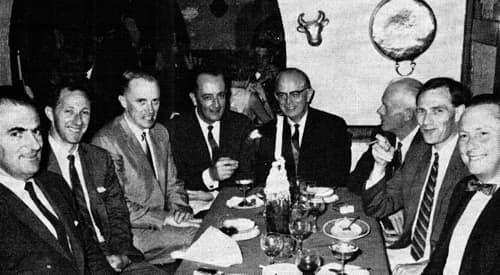
Above: 1966 Dinner meeting at The Golden Ox restaurant in Sydney, Autralia after a seminar sponsored by the Australian Society of Cosmetic Chemists. From left to right: Matt Patterson (Yardley), Keith Ball (Colgate), Windy Burger (Kolmar), J. Wiggers DeVries (Lockwood, Magrath), Maison G. deNavarre (Beauty Counselor), Max Chambers (Coty), Roy Sinclair (Coty) and Bob Brady (Colgate) (Desiderata, American Perfumer, 1966).
Like the American Society of Cosmetic Chemists, the International Federation recognised Maison’s role in its establishment and promotion with the creation of the Maison G. de Navarre Young Scientist Prize, which is awarded biannually.
Legacy
Maison’s importance to the development of cosmetic chemistry cannot be overestimated. As well as directly disseminating knowledge through his articles, books and Desiderata column his ability to bring people together to share information helped lay the foundations for the science of cosmetic chemistry that we know today.
First Posted: 27th July 2020
Last Update: 27th February 2021
Sources
50 years of the Society of Cosmetic Chemists. (1995), Cosmetics and Toiletries, December.
deNavarre, M. G. (1932). Absorption bases. The American Perfumer & Essential Oil Review. December, 537-539.
deNavarre, M. G. (1933). Vitamins A and D in cosmetics. The American Perfumer & Essential Oil Review. May, 121-132.
deNavarre, M. G. (1941). The chemistry and manufacture of cosmetics. Boston, MA: D. Van Nostrand Company, Inc.
deNavarre, M. G. (1957). International encyclopedia of cosmetic trade names. New York: Moore Publishing Company.
deNavarre, M. G. (1962-75). The chemistry and manufacture of cosmetics (2nd ed., Vols. I-IV). Orlando, FL: Continental Press.
Klarmann, E. G. (1952). Maison G. de Navarre, the cosmetic chemist. Journal of the Society of Cosmetic Chemistry, 3(2), 135-141.
Sagarin E. (1952). Up to now: An historical note. Journal of the Society of Cosmetic Chemistry, 3(4), 47-51.
S.C.C. Medalist for 1951. (1951). The American Perfumer & Essential Oil Review. December. 442, 455.
Sheppard, J. (Ed). (1928) . The griffin. Detroit: College of Detroit.
Stoltz, C. L. (Ed). (1929) . The griffin. Detroit: College of Detroit.
Stoltz, C. L. (Ed). (1930) . The griffin. Detroit: College of Detroit.
Wright, H. J. (1952). Maison G. de Navarre, the man. Journal of the Society of Cosmetic Chemistry, 3(2), 141-145.
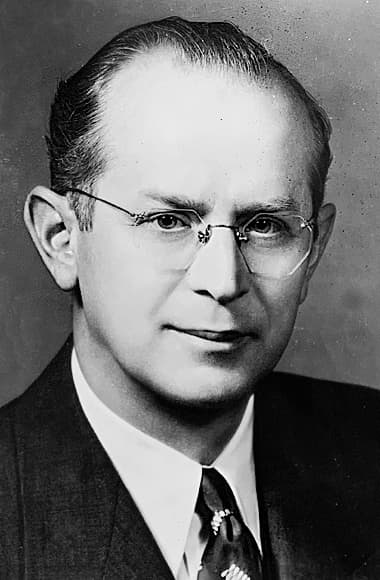
Maison Gabriel deNavarre [1909-1983] a.k.a Edward Maicki. He married Jeanette Dutts [1908-1994] in 1938.
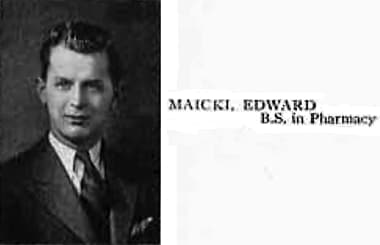
1930 Edward Maicki, B.S. in Pharmacy.
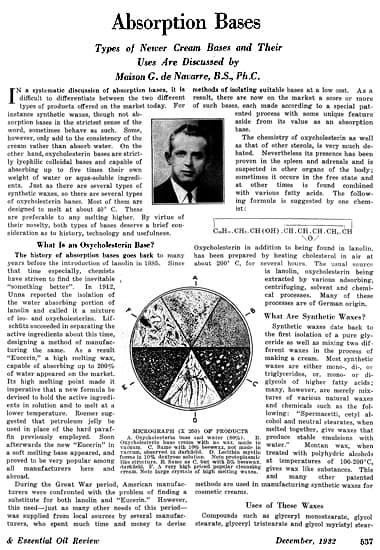
1932 First page of ‘Absorption Bases’ as it appeared in ‘The American Perfumer & Essential Oil Review’.
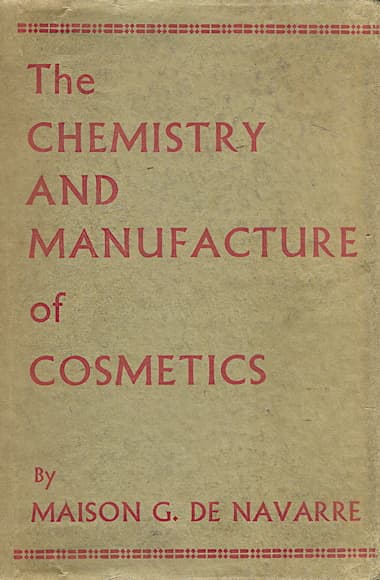
Cover of ‘The Chemistry and Manufacture of Cosmetics’ (1941).
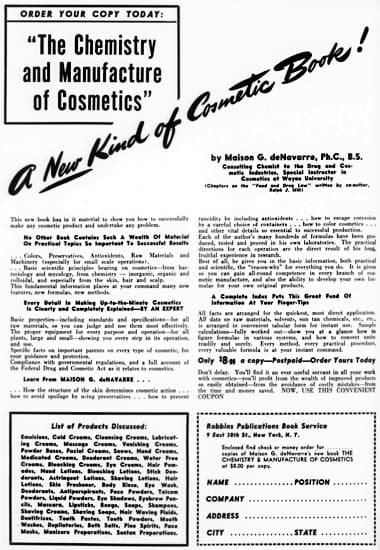
1943. Advertisement for ‘The Chemistry and Manufacture of Cosmetics’.
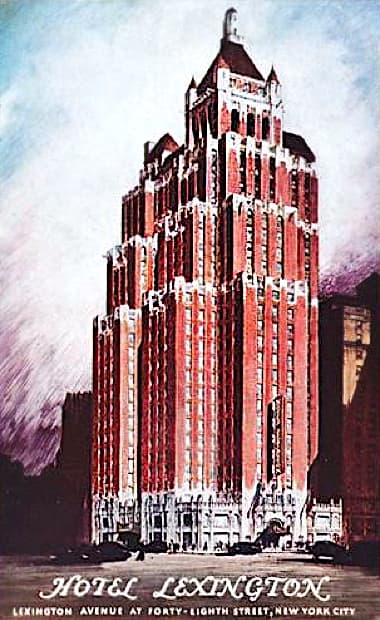
Lexington Hotel opened in 1929. Architects: Schultze & Weaver.
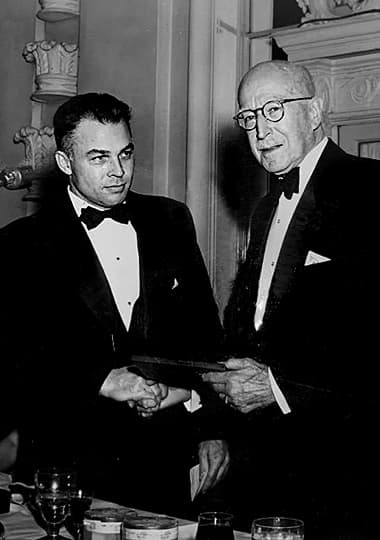
1948 The first Maison G. de Navarre Medal Award presented to Col. Marston T. Bogart (right) from serving SCC President Walter Taylor.
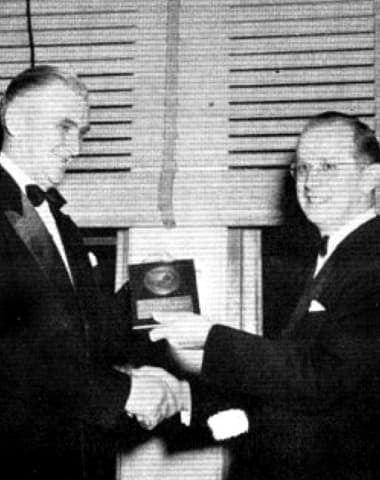
1951 Maison G. de Navarre receiving the Maison G. de Navarre Medal Award from SCC president Everett G. McDonough. Maison was on the early committees that selected the recipients for the medal so was not eligible for the award.
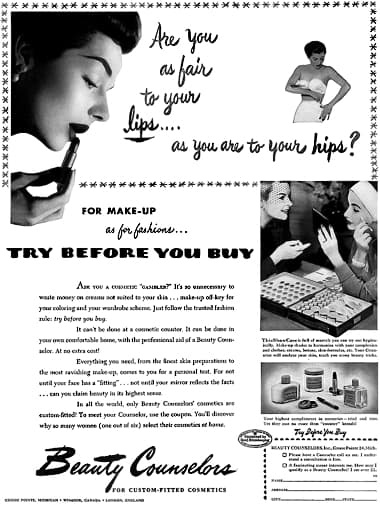
1953 Beauty Counselors.
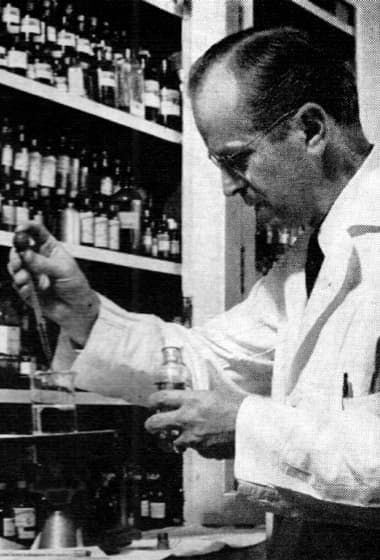
Maison G. deNavarre in a laboratory.
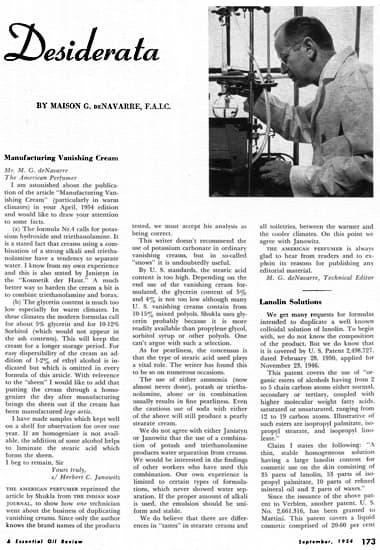
1954 Desiderata by Maison G. deNavarre (Technical Editor). What had started out as a single column in the American Perfumer in 1933 now extended over two pages.

1956 Maison conversing with Henri-Marcel Gattefossé [1910-1972] (left), the son of René-Maurice Gattefossé [1881-1950] on Maison’s first visit to Paris.
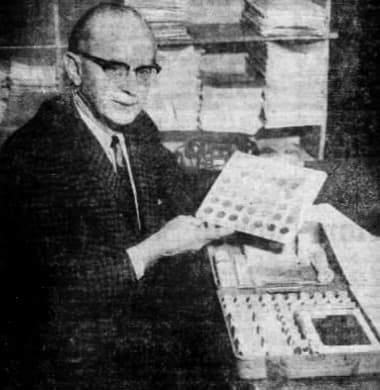
1967 Maison G. deNavarre examining a Beauty Counselor sample kit.
